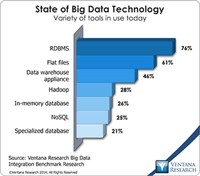In today’s data-driven world, organizations need real-time access to up-to-date, high-quality data and analysis to keep pace with changing market dynamics and make better strategic decisions. By mining meaningful insights from enterprise data quickly, they gain a competitive advantage in the market. Yet, organizations face a multitude of challenges when transitioning into an analytics-driven enterprise. Our Analytics and Data Benchmark Research shows that more than one-quarter of organizations...
Read More
Topics:
embedded analytics,
Analytics,
Business Intelligence,
IBM,
IBM Watson,
AI & Machine Learning
It’s part of my job to cover the ecosystem of Hadoop, the open source big data technology, but sometimes it makes my head spin. If this is not your primary job, how can you possibly keep up? I hope that a discussion of what I’ve found to be most important will help those who don’t have the time and energy to devote to this wide-ranging topic.
Read More
Topics:
Big Data,
Microsoft,
Teradata,
Business Analytics,
Business Intelligence,
IBM,
Information Management,
Operational Intelligence,
Oracle,
HPE,
ODPI,
Strata+Hadoop
Last week I attended the IBM Big Data Symposium at the Watson Research Center in Yorktown Heights, N.Y. The event was held in the auditorium where the recent Jeopardy shows featuring the computer called Watson took place and which still features the set used for the show – a fitting environment for IBM to put on another sort of “show” involving fast processing of lots of data. The same technology featured prominently in IBM’s big-data message, and the event was an orchestrated presentation more...
Read More
Topics:
Big Data,
EMC,
Analytics,
Business Analytics,
Business Intelligence,
Cloud Computing,
Cloudera,
Customer & Contact Center,
Greenplum,
IBM,
Information Applications,
Information Management,
InfoSphere,
Location Intelligence,
Operational Intelligence,
IT Performance Management (ITPM),
Strata+Hadoop
Read More
Topics:
Data Warehousing,
Microsoft,
RDBMS,
SAS,
Teradata,
Analytics,
Business Intelligence,
Cloud Computing,
Data Management,
HP,
IBM,
Information Management,
Oracle,
IT Performance Management (ITPM)
In the weeks leading up to and as part of its Information On Demand Conference that my colleague assessed, IBM introduced version 8.5 of InfoSphere Information Server and several related product updates. As my colleague suggested earlier, IBM has an ambitious agenda to provide comprehensive information management capabilities through a combination of product development and acquisitions. The breadth of this portfolio is impressive, and InfoSphere Information Server 8.5 makes significant strides...
Read More
Topics:
Enterprise Data Strategy,
Analytics,
Business Analytics,
Business Intelligence,
CIO,
Data Integration,
IBM,
Information Management,
Information Technology,
IT Performance Management (ITPM)
On October 25, IBM introduced Cognos 10 at its Information on Demand and Business Analytics Forum in Las Vegas that I attended to review the technology closer from my examination at its recent IBM Business Analytics analyst summit in September. According to Rob Ashe, IBM’s general manager of business analytics, Cognos 10 has been developed for over six years. You’re probably aware that in that period IBM made a variety of acquisitions including Cognos itself. These acquisitions and their impact...
Read More
Topics:
Enterprise Data Strategy,
Performance Management,
Planning,
Analytics,
Business Analytics,
Business Intelligence,
CIO,
IBM,
Information Management,
IT Performance Management (ITPM)













